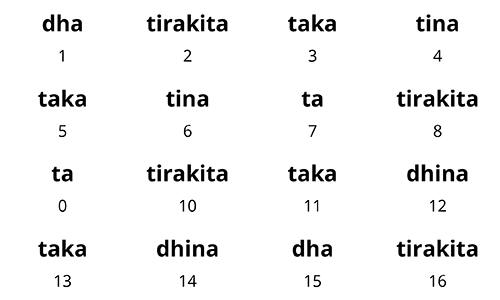Chalan – चलन
Quick Definition: Most often, the chalan is a simple cyclic form with a strong movement or groove, sometimes used as a base-rhythm for a rela. But the term may also refer to a number of different compositional forms depending on lineage or region.
Literal Meaning: moving; gait; behavior
Chalan Overview
Chalan is another poorly defined term which has a number of different meanings, depending on the gharana, player, or region.
The most common meaning appears to be a relatively simple cyclic composition with a strong groove or movement. However, there is also a more formal kind of chalan, as well as some less common meanings of the term.
The term chalan is derived from chalnā (चलना), meaning to “to go” or “to move”. And so for most, chalan is related to “movement” or “gait“, and suggests a particular rhythm or groove. Numerous authors and performers also believe that the term chalan originally comes from kathak dance.
Here is how a few different authors describe the chalan:
- Sadanand Naimpalli: “The Chalan is a catchy sequence of bols, which by itself can be played like a Kaida or L’ggi.” (p. 24)
- Sudhir Saxena: “Chalan is a simple recurring movement of a small bol-pattern at a fast pace, and is somewhat similar to a relā. The word may also be taken to mean the distinctive style in which an individual tablā player plays a particular pattern.” (p. 54)
- Aneesh Pradhan: “It denotes a composition with a pattern that suggests a gait. At times, the theme of a chalan is also used to launch into a rela or rav.” (p. 26)
- Gert-Matthias Wegner: “Calan are compositions with improvised variations, originating from the kathak dance repertory, where they are played to describe some character appearing on stage.” (p. 47)
Chalan-to-Rela or Rao
The most common kind of chalan will have a particular rhythmic division which is often used to introduce a rela or rao with the same rhythmic division. These compositions are cyclic in form, often similar to a laggi or simple kayda.
This is a common practice across the gharanas, though the introductory composition is not always called chalan. In the Benares lineage of Chhotelal Misra, this is called a prabandh bant (प्रबन्ध बाँट), or "arranged bant".
Bant:

Rela with same rhythmic divisions:

In the following demonstration, the bant (chalan) is played 4 times followed by the rela 4 times. This sequence is repeated twice:
Sadanand Naimpalli of the Farrukhabad gharana gives similar pairs, but calls them chalan and rao (the rao is similar to a rela):
Chalan:

Rao:

In both examples, we see the bant and the chalan forming the underlying rhythmic pattern. The rela or rao then follows the same basic pattern, but with a denser (faster) pattern.
There is also some correspondence of bol (phrases) in both cases. Usually the most prominent open bols (or similar bols) are included in both the chalan and the rela, as well as the same overall tali-khali pattern.
Farrukhabad Chalan
There is also a more formal kind of chalan known as Farrukhabad Chalan. The most well-known of these Farrukhabad chalans was made famous by Ahmedjan Thirakwa. This chalan is given in numerous books, including Chhotelal Misra’s theory book Tal Prabandh:

In the recording below, Ahmedjan Thirakwa performs a version of this chalan, though it lacks the tali-khali structure given above (he plays only the first half).
Chalan Performed by Ahmedjan Thirakwa Khan:
Anindo Chatterjee (Farrukhabad gharana) and Sudhir Saxena (Ajrara gharana) have also published this as a chalan.
However, this composition is sometimes called by other names. Vijay Shankar gives this composition as a “gat of Ustad Ahmedjaan Thirakwa” (p. 29)
And Wegner calls this a kinar gat, (p. 41) which he also attributes to Thirakwa Khan, his teacher’s guru. And so Thirakwa himself likely called this a gat.
Other Kinds of Chalan
Anindo Chatterjee, a student of Gyan Prakash Ghosh, teaches a number of other chalans which are simply known as kaydas in other gharanas. While others are similar to gats.
Wegner, a student of Nikhil Ghosh, gives a number of chalans which might be called rela by some, or bant in Benares. One such chalan is identical to Benares Bant 3.
And some Benares players use the term chalan for tekha prakar.
This obviously leaves us with a very confusing list of meanings for the term chalan. But the most popular is the informal form given above: a simple cyclic composition with a strong groove or movement, which may or may not be the basis for a rela or rao.
References
Chatterjee, Anindo. Chalan, popularized by Ustad Ahmed Jaan Thirikwa KhanSahab. Retrieved from https://acst.viewcy.com/ (no longer running).
Misra, Chhote Lal. Tal Prabandh. New Delhi: Kanishka Publishers, 2006. (Hindi)
Mishra, Vijay Shankar. Tabla: Rare Compositions of The Great Masters. New Delhi: Kanishka Publishers, 2014
Naimpalli, Sadanand. Tabla for Advanced Students. Mumbai: Popular Prakashan Pvt. Ltd., 2009.
Pradhan, Aneesh. Tabla: A Performer’s Perspective. Aneesh Pradhan, 2011 (self-published)
Saxena, Sudhir Kumar. The Art of Tabla Rhythm. New Delhi: D.K. Printworld (P) Ltd., 2006.
Thirakwa, Ahmedjan. Reel One (Vilambit Laya). On Thirakwa: Bombay 1964. West Hurley: Simla House. (1999).
Wegner, Gert-Matthias. Vintage Tabla Repertory – Drum Compositions of North Indian Classical Music. New Delhi: Munshiram Manoharlal Publishers, 2004.
Music Sources
(Note: Audio excerpts are presented for educational purposes only under the Fair Use doctrine.)
Thirakwa, Ahmedjan. Reel One (Vilambit Laya). On Thirakwa: Bombay 1964. West Hurley: Simla House. (1999).